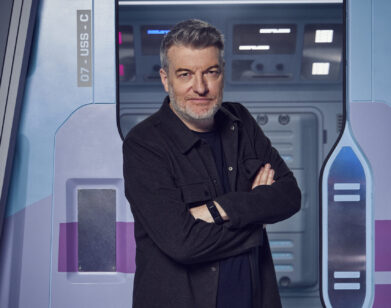The Makings of a Man

ABOVE: TOM SWEET AND STACY MARTIN IN THE CHILDHOOD OF A LEADER.
Much like Quentin Tarantino’s Inglourious Basterds imagines a violent and satisfying demise for Adolf Hitler, actor-turned-director Brady Corbet’s feature debut, The Childhood of a Leader, imagines a fascist leader’s fictional childhood. Out today, the film follows a young boy’s experiences through the end of the First World War that would shape him into an unforgiving leader of the un-free world.
While Corbet is best known for his front-of-camera work in artful films like Funny Games, Melancholia, and Martha Marcy May Marlene, Childhood catapults him into the echelons of today’s most exciting young auteurs. The film won Corbet the best director and best debut prizes at this year’s Venice International Film Festival—and with good reason.
Taking visual cues from the likes of Stanley Kubrick, the film is cloaked in the dread of the era while also being a stunning period portrait of a time come and gone. Paired with visionary composer Scott Walker’s score—one which Corbet praises as “one of the great film scores”—and matched with excellent turns from Robert Pattinson, Liam Cunningham, Bérénice Bejo, and breakout Tom Sweet as “The Boy,” The Childhood of a Leader gets in your head and stays there, for better or worse.
Two days before the film’s debut, Corbet took a break from playing dad with his partner and co-writer Mona Fastvold and their soon-to-be two-year-old daughter to speak with Interview about history’s fascist leaders and why a movie about Donald Trump would be boring.
BENJAMIN LINDSAY: I’ve read that The Childhood of a Leader is based on Jean-Paul Sartre’s story of the same name from 1939. What was your relationship with that source material prior to filming?
BRADY CORBET: Well, actually, the book that the film owes a bit more to than Jean-Paul Sartre’s short story is Margaret MacMillan’s book Paris 1919, which was a chronicle of the events leading up to the signing of the Treaty of Versailles in June 1919. I read that book about 10 or 11 years ago, and I was really haunted by it, and I decided then that I’d like to make a film on the subject. But I knew that I would have to figure out a way to tell that story inside of a microcosm because it was too sprawling, too expensive, and frankly, an exact retelling didn’t leave a lot of room for poetry. It was just a lot of bureaucratic rhetoric. So basically, it started off with that, and then I had this idea to have the protagonist be a character who was sort of the result of these events—the character is almost the physical manifestation of a premonition. As that treaty or series of treaties paved the way for the rise of fascism 20 years later, I decided to try and tell this fictional account of this young would-be fascist’s childhood. That led me to reading biographies of young Stalin, Mussolini’s childhood, et cetera, et cetera. And then I actually discovered an article called “The Childhood of a Leader,” which I didn’t know had taken its name from Jean-Paul Sartre’s short story, and the title I thought was very, very impactful. Shortly thereafter, I made the correlation between Jean-Paul’s short story and the title, so then I read Jean-Paul’s short story… Especially when Mona became involved and finished writing the screenplay with me, then it took on a life of its own and it had less and less to do with those sources of inspiration, but we decided to cite them and keep them there anyway so that it would be a sort of mixtape of the 20th century.
LINDSAY: Do you feel like now is a time that this film is particularly resonant?
CORBET: I think what stuck was that the story would never not be relevant. Also, it’s interesting to gauge the response in the U.K. right now compared to the U.S.—In the U.K., they’re not dreading something happening, something already has happened. So critics and stuff are viewing the film very much through that prism and so they’re projecting all of their own experiences and notions onto the film. Of course, that’s part of the reason that the film is designed in such a way that there’s space. It’s not a plot-y film; it’s a film that leaves plenty of room for contemplation.
LINDSAY: Personally, I couldn’t help but think of Hillary Clinton’s “role model” ad showing the children listening Donald Trump—just the circumstances that do shape a childhood and make these kind of intrinsic ideologies in a soon-to-be man.
CORBET: Completely! I was away for many years from the U.S. until September, and I was barely here because Mona and I had a daughter. We had our daughter in Norway, and we were working mostly in Paris and it was shot in Budapest. So we were travelling a lot. I was really outside of what was going on in the U.S. political sphere. When I landed, that was the first time that I ever knew it was a possibility that Donald Trump would become the Republican nominee. It was during that period that people said, “He probably won’t, but he could become the nominee.” So obviously now that he’s the nominee everyone’s terrified…. If I was going to make a film about the childhood of Donald Trump, I think I can make an educated guess and say that it would not be particularly cinematic or interesting—because he is not very interesting. He is just an opportunist. It’s terrible, because he seems to abandon his own ethics and morals on a daily basis just for the press, for the notoriety. He’s definitely a bigot, but he’s that crazy uncle that you avoid at reunions. But somebody has given him the red button, and he’s just ready to push it. That’s really scary.
LINDSAY: Oh, it’s baffling. Going back to the film, I also wanted to talk to you about the casting process, especially with regard to “The Boy,” Tom Sweet. How did you find him?
CORBET: There was a good thing and a bad thing about the process of looking for this boy, which was that we knew we were looking for something extremely specific. We needed a little boy that looks like a little girl that feels like he could disappear into the era, and that has good diction and is ideally bilingual—a boy that speaks French and English. What we found were all of those characteristics, and Tom is quite bilingual, but German and English. As soon as I realized he’s capable of taking on another language, I knew it would be easy enough for him to pick up the French, and he just worked on it for months and months. But he was found on a soccer field. The casting director saw him on a soccer field and asked him to come in and audition. He’d never acted before.
LINDSAY: You started acting at a relatively young age as well. Do you feel like your roots in front of the camera at all enhanced your role as director?
CORBET: Yeah, I’m sure, but pretty much as far back as I can remember, I was really a cinephile. It was that kind of mentality where I really wanted to see everything, I wanted to know about everything. And so I think that my prior experience made me sensitive to what the actors were going through, which was fairly important, especially the way that I like to make movies because it’s long sequence shots, which means it’s a lot of dialogue, a lot of choreography. It takes a long time to get it right. I knew from experience that the most important thing to be was supportive of everyone.
LINDSAY: For this style of long sequences, you really found the perfect complement with composer Scott Walker. How is it that he came on board?
CORBET: I just wrote him. He said yes very quickly, which I was truly shocked by. He was on board as early as anybody was—he was on board three and half years ago, four years ago. I was terrified that I would lose him because we kept losing the money, and it’s one of those things where when he commits to something, he commits to it fully. So by him committing to your project, it means that he’s not working on other projects of his own. So it was very painful to constantly have to deliver that news to him because he’s so focused and works so sparingly. But I think in the long run, I think he’s very proud of it. I know I’m really proud of it—I think it’s one of the great film scores.
THE CHILDHOOD OF A LEADER HITS THEATERS AND IS AVAILABLE ON VIDEO ON DEMAND TODAY, JULY 22, 2016.






